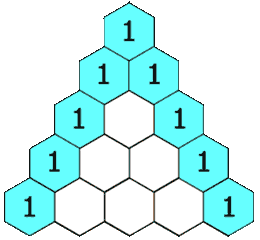118. Pascal's Triangle
1. Description
Given an integer numRows, return the first numRows of Pascal’s triangle.
In Pascal’s triangle, each number is the sum of the two numbers directly above it as shown:
2. Example
Example 1:
Input: numRows = 5
Output: [[1],[1,1],[1,2,1],[1,3,3,1],[1,4,6,4,1]]
Example 2:
Input: numRows = 1
Output: [[1]]
3. Constraints
- 1 <= numRows <= 30
4. Solutions
My Accepted Solution
n = numRows
Time complexity: O()
Space complexity: O()
class Solution {
public:
vector<vector<int>> generate(int numRows) {
vector<vector<int>> rows;
for(int i = 1; i <= numRows; ++i) {
vector<int> row(i, 1);
for(int j = 1; j < i - 1; ++j) {
row[j] = rows[i - 2][j - 1] + rows[i - 2][j];
}
rows.emplace_back(move(row));
}
return rows;
}
};
